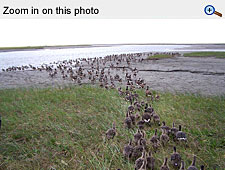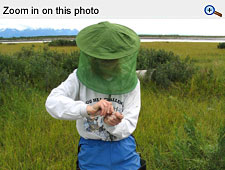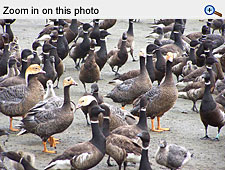Avian Influenza Facts

Black Brant geese return to the water in Chevak after being tested for the presence
of avian influenza virus.

Heather Huson, UAF research technician, prepares a swab from a Dusky Canada goose
in Copper River Delta, Cordova, Alaska, during a biennial banding project organized
by Mike Petrula of the Alaska Department of Fish and Game Division of Wildlife Conservation.

Emperor and Black Brant geese gather on the mudflats in Chevak, Alaska.
by Marie Gilbert, Institute of Arctic Biology
What is avian influenza?
Avian influenza, or "bird flu," is a contagious disease of animals caused by viruses that normally infect only birds, and less commonly, pigs. All birds are thought to be susceptible to infection, though domestic poultry, including chickens and turkeys, are particularly susceptible. The disease, first identified in Italy more than 100 years ago, occurs worldwide.
Migratory waterfowl--most notably wild ducks--are the natural reservoir of avian influenza viruses worldwide. Many of these birds are migratory, travel long distances across international borders and have been shown to introduce novel influenza genes into other bird populations. When new viral gene segments mix with existing viruses they can generate new deadly (also called pathogenic) viruses.
Why is H5N1 of particular concern?
Of the 15 avian influenza virus subtypes, H5N1 mutates rapidly and has a documented tendency to acquire genes from viruses infecting other animal species. Its ability to cause severe disease in humans has been documented in 117 cases from Indonesia, Vietnam, Thailand and Cambodia. The World Health Organization has reported 60 deaths--most in Vietnam--as of Oct. 10, 2005.
Since the recent version of H5N1 first showed up nine years ago in a Hong Kong goose, hundreds of millions of domesticated birds have died or been culled. Until this summer the virus had not been seen outside southern China and Southeast Asia. Now the virus has been spotted in Kazakhstan, Siberia, Northwest China, Mongolia, Tibet, Turkey, Greece, and Romania.What happens to samples from Alaska?
Alaska bird samples which test positive for avian influenza virus will be sent to The Institute of Genomic Research (TIGR) for sequencing of the entire viral RNA genome and will then be published in GenBank, the National Institutes of Health collection of all publicly available RNA and DNA sequences.
With gene sequences, bird species, geographic location and capture information in hand, Tom Marr, UA president’s professor of bioinformatics; Jim Long, IAB biotechnology computing technical leader; and Buck Sharpton, UA president’s professor of remote sensing and UAF chancellor’s director of research, plan to create the first web site of avian influenza data organized by geographic location.
How does the disease spread from country to country?
Avian influenza can spread through international trade in live poultry. Migratory birds, including wild waterfowl, seabirds and shorebirds, can carry the virus for long distances and have been implicated in the international spread of highly pathogenic avian influenza. Migratory waterfowl--most notably wild ducks--are the natural reservoir of bird flu viruses, and these birds are the most resistant to infection. They can carry the virus over great distances and excrete it in their droppings, yet develop only mild and short-lived illness. Domestic ducks, however, are susceptible to lethal infections, as are turkeys, geese and several other species raised in commercial or backyard farms.
A book about the 1918 flu--including Alaska’s unique role:
Flu : The Story Of The Great Influenza Pandemic of 1918 and the Search for the Virus
That Caused It, by Gina Kolata, 1999.


